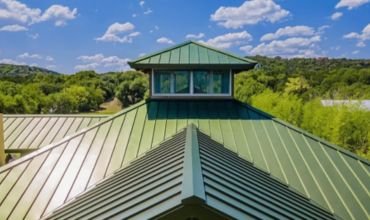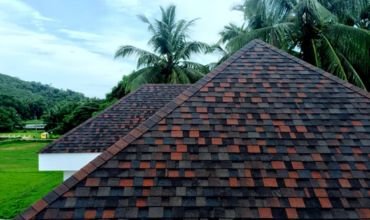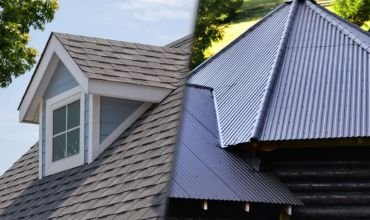In this guidebook to Tin Roofs vs Asphalt Shingles, we offer a clear answer to the question, “Is Tin Cheaper Than Asphalt Roofing?” which will help you navigate the sea of information and make a choice that aligns with your needs, budget, and vision for your home.
Roofing adds the final touch to a building project, so its significance cannot be overlooked. Acting as the guardian against the elements, a roof’s role in preserving the structural integrity of your home and providing comfort is essential. However, the quest for the perfect roofing material is influenced by a medley of factors.
So, when it comes to selecting the right roofing material for your home, the decision often feels as weighty as the roof itself. With plenty of options, metal and asphalt shingles emerge as frontrunners due to their desirable balance of cost-efficiency, durability, and ease of maintenance. Yet each carries its own set of advantages and disadvantages, weaving a complex jumble of considerations. Let’s begin to discuss.

Tin roofs are made from soft metals coated in a mixture of tin and lead, often including aluminum. Although actual tin is rarely used for roofing today, the phrase “tin roof” persists as a general term for various types of metal roofing, including those made from steel or galvanized steel.
Metal roofs consist of panels or shingles made from materials like steel, aluminum, zinc, tin, or copper and come in a variety of designs, such as corrugated, standing seam, or metal tiles. These aluminum tiles for roofs are now available in a wide array of colors, designs, and finishes. Moreover, they are versatile enough to be a good fit for any type of roof, regardless of its slope.
| Advantages | Disadvantages |
| • More durable • Lifespan of 40-200 years • Low maintenance when properly installed • Resistant to corrosion, fire, and lightning • Reflects solar heat, reducing energy costs • Often made from recycled materials • Environmentally friendly • Thermal properties can create discomfort in hot weather | • More Expensive • More difficult to install and repair • Noisy during rain or storms • Limited color matching for replacements • Potential for dents from debris • Significant waste during manufacturing (up to 40%) • Fades in bright sun • Wind resistance issues with large sheets |

Asphalt shingles are available in three primary forms: three-tab, luxury, and dimensional. They are constructed from either an organic mat or fiberglass, both infused with asphalt and finished with protective granules to shield against UV rays.
Moreover, Asphalt shingles are cost-effective and are known for their ease of installation or repair. They are available in a wide range of colors and patterns to match any home exterior. Additionally, these shingles vary in durability, with higher-quality options providing better resistance to weather conditions.
| Advantages | Disadvantages |
| • Inexpensive • Easy to install; can often go over existing shingles • Highly customizable with many colors and styles • Wind and water-resistant, ensuring longevity • Lightweight and easy to transport • Individual shingles can be easily replaced • UV, electromagnetic, and flame-resistant • Naturally sound resistant | • Can develop algae or moss, requiring periodic checks • Some shingles may end up in landfills, releasing pollutants • Other materials (e.g., slate, ceramic) may outlast shingles • Tend to retain heat if under-insulated • Difficult to recycle due to petroleum reliance |
The cost difference between these two roofing options varies based on the specific type of asphalt shingle or metal roof you choose. So, let’s explore the pricing for a new roof:
| Tin Roof Price Per Square Foot | Asphalt Roofing Price Per Square Foot |
| The Tin Roofing Cost starts at $4 per square foot for aluminum options and can reach up to $30 per square foot for those made of copper. Often, metal roofing comes with a warranty that only covers the paint or coating on the panels. Although choosing metal might require a larger initial investment, it offers a longer lifespan. | On average, asphalt shingles are priced between $3.50 and $5.50 per square foot, based on their kind. The simplest versions start at about 80 cents per square foot, with the more sophisticated architectural shingles going up to $9 per square foot. Although they are more budget-friendly at the outset, asphalt shingles tend to need more upkeep compared to metal roofs and often require replacing sooner. |
As you have discovered that Asphalt Roofing is cheaper than Metal Roofing, you must understand why the price for metal roofing is set higher.

When deciding between two options, you must consider your budget, the climate of your area, and your specific needs. Higher quality often comes with a higher price but also a longer lifespan. So, weigh your options based on what you can afford and what best meets your requirements.
Now, you must have answered the question, “Is Tin Cheaper Than Asphalt Roofing?” in the digital battle of Tin Roof vs. Shingles. So, whether you choose tin or asphalt, you must consider the budget, style, and high-quality material before installing. Are you also the one searching for “Steel Roofing Contractors Near Me”? We recommend choosing ManageMyRoof for modern roof repair or installation.
Asphalt shingles are the most budget-friendly, making them a popular choice for homeowners looking for a cost-effective roofing solution without compromising too much on durability.
Rolled Roofs offers the lowest initial cost for homeowners. Its popularity stems from its affordability, ease of installation, and a wide variety of styles.
Tin, often referred to as a type of metal roofing, is excellent for roofs due to its durability, longevity, and resistance to extreme weather. It’s also recyclable.
Metal roofing stands out as the most efficient material, reflecting solar heat and cutting cooling costs.
Asphalt Shingles are less expensive due to their straightforward design, which requires fewer materials and labor. This makes them a cost-effective option for many homeowners.
The top choices include asphalt shingles for their affordability, metal for durability, cedar shakes for a natural look, composite shingles for versatility, and slate roofs for longevity.
With proper installation and maintenance, metal roofs can last 40-70 years effectively. Their lifespan surpasses that of many other materials, making them a wise investment.
The primary issue with metal roofs is their tendency to expand and contract with temperature changes. If not properly managed, this can lead to the loosening of fasteners and potential leaks.
Architectural asphalt shingles are renowned for their durability. They are thicker and offer more layers than standard shingles, providing better protection and a longer lifespan.
Metal roofing is superior in reducing heat absorption due to its reflective properties. It can significantly lower cooling costs in warmer climates by reflecting sunlight away from the building.
Leave a Reply